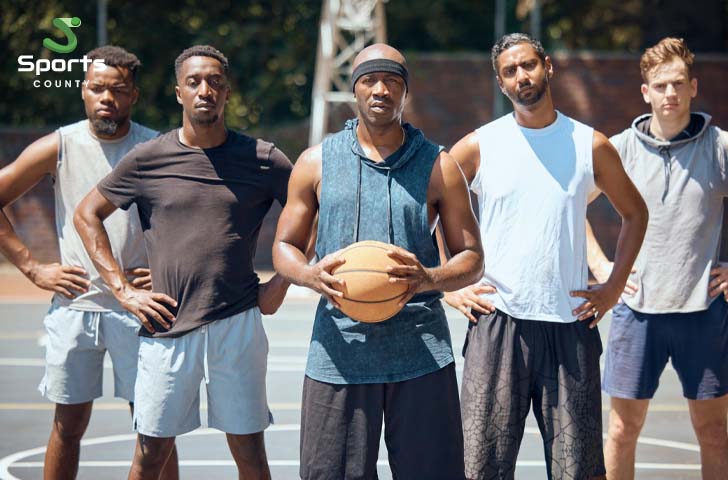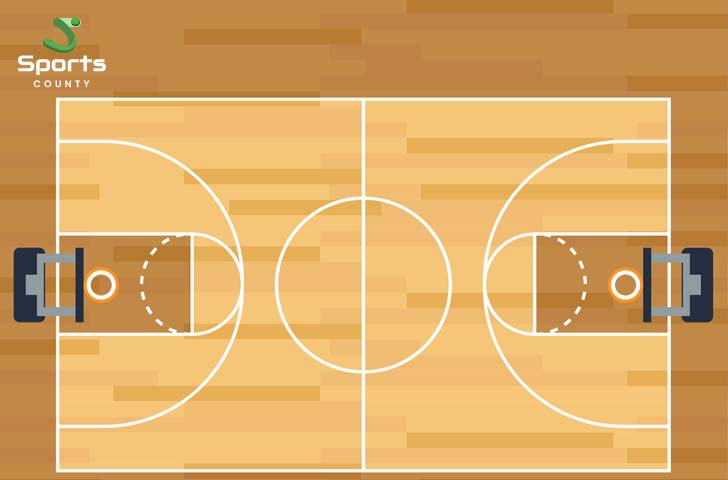Exploring the world of basketball for beginners involves mastering fundamental skills and understanding the dynamics of the game. From shooting techniques to dribbling skills and teamwork, this comprehensive guide encapsulates everything you need to learn about this sport. If you’re wondering how to play basketball, this guide will provide step-by-step instructions and tips to get you started.
You will learn the fundamentals, techniques, and important strategies for winning that lay the groundwork for a fulfilling and prosperous basketball career. Thus, this guide is your doorway to the thrilling world of basketball, regardless of whether you’re a beginner or looking to improve your talents.
About Basketball

Comparable to a massive game of catch and shoot between two teams of five players, basketball began in the USA in the 1890s and is currently incredibly well-known all over the world. The basic goal is to outscore the other team by tossing the ball through a towering ring. A basic long-range shot carries two points, whereas an advanced one carries three. To move closer to the hoop for a shot, players dribble the ball, bounce it while sprinting, and then pass it to one another.
The game is exciting and fast-paced because the other team attempts to grab the ball and block the shot. Rules are in place to ensure fair play, such as prohibiting running with the ball and refraining from pressing. The actual excitement is in the incredible plays, teamwork, and the satisfaction of making a basket. The team with the most points wins in the end.
Also Read: 30 Interesting Basketball Facts Which Will Leave Your Jaw Dropped
Rules to Keep in Mind While Playing Basketball
Like every other sport, basketball has its own set of rules that one must learn before attempting the sport. Let’s dive into the basketball rules for beginners:
- Team Size: Each team has five players on the court. Breaking this rule results in losing possession.
- Scoring: In basic basketball rules, scoring is with various values assigned to shots inside and beyond the three-point line. A team must score more field goals than their opponent to win.
- Shot Clock: A shot clock keeps track of the teams’ allotted shooting time, which is either 24 or 30 seconds. If it fails, the other team takes control.
- Dribbling: Players advance by passing or dribbling. Stopping dribbling means they must pass or shoot. Running with the ball is a violation.
- Inbounding: After scoring, the offence has 5 seconds to inbound the ball. Failure results in losing possession.
- Half-Court Line: Once past half-court, a player cannot cross back, or the opposing team gains possession.
- Stay Inbounds: Players must stay within court boundaries. Stepping out awards possession to the opponent.
- Goaltending: Defenders can’t interfere with a shot in a downward trajectory; doing so results in a field goal for the offence.
- Defence Tactics: Defenders aim to block or steal the ball without illegal interference.
- Paint Violation: Offensive players can’t linger in the paint for more than 3 seconds.
- Team Fouls: Teams have a limited number of fouls per quarter, leading to free throws for the opponent after surpassing the limit.
- Technical Fouls: Violating administrative rules, like fighting or verbal abuse, results in free throws and possession change.
Arena- About The Field

The basketball court is a rectangular playing surface designed for the fast-paced sport. It is divided into two main sections and has various lines. Let us now understand what this field looks like:
Dimensions and Form:
- Envision a huge rectangle, like a compressed box.
- Measuring from the inside edges of the boundary lines, it is 94 feet long (28.65 meters) and 50 feet wide (15.24 meters).
- Thus, the overall area used for play is around 4,700 square feet.
Important Marks:
- The sidelines and end lines indicate the court’s boundaries. You’re out of bounds if you cross these lines.
- The centre line divides the court into two halves, which run across its middle.
- The free throw line is situated at 15. feet (4.57 meters) from the basket and is curved. Players position themselves here to attempt 1-point free throws following fouls.
- The three-point line is an arc further from the hoop than the free-throw line. Shots from behind this line are a valuable scoring opportunity worth three points.
- The lane, also called the “paint” or “key,” is the painted rectangular space beneath each basket. The free-throw line, baseline, and sidelines border the lane.
Additional characteristics
- Baskets: Each basket has an 18-inch (46 cm) ring in diameter and a net attached below. These are mounted on backboards at each end of the court, 10 feet (3.05 meters) high.
- Free Throw Circles: These are semi-circular areas around the free throw line where players stand to shoot free throws
The Objective of the Game:
Basketball is a captivating blend of speed, skill, and strategy, with players showcasing their athleticism through precise dribbling, accurate shooting, and cohesive teamwork. As the clock ticks, it brings out the players’ relentless pursuit of scoring and defensive prowess. Let us now understand some objectives of this sport:
1. Coring:
- Throw the ball through the hoop to score points!
- Fancy shots from far away are worth 3 points, and regular shots closer in are worth 2 points.
- If someone breaks the rules, you get free throws worth 1 point each.
2. Teams:
- Five players per team play at once.
- They take turns attacking and defending (like offence and defence in tag).
3. Playing:
- To score, the team with the ball tries to pass and dribble it toward the basket.
- By stealing the ball, making it difficult to pass, and blocking shots, the opposing team tries to stop them.
4. Time:
- Each team has a limited shooting time (like a sand timer). The other team gets the ball if they don’t shoot in time.
5. Bouncing Back:
- Teams fight to grab the ball (rebounding) when someone misses a shot. This lets them keep attacking or stop the other team from scoring.
6. Winning:
- The team with the most points at the end wins! Sometimes, they might need extra time to break a tie.
Also Read: 10 Best NBA Players Of All Time Who Reigned Supreme In Basketball
Equipment and gear required to play basketball

Let us now talk about some equipment used to play basketball:
- Basketball: This is undoubtedly the most crucial piece of gear! Various basketball sizes are available according to the player’s age and gender. A women’s ball is size 6, and a regular men’s ball is size 7. Even tiny are youth balls.
- Basketball hoop: Players shoot the ball towards the hoop. It is affixed to a backboard and stands ten feet tall. Various materials can be used for the backboard, including wood, acrylic, and glass.
- Shoes: The fast movements and jumping needed for the game are made possible by the traction and support of basketball shoes. To shield the feet from contact, they must be adequately padded as well.
Extra equipment:
- Socks: Keep your feet comfortable and absorb sweat to avoid blisters.
- Ankle braces: Because sprains are common in basketball, ankle braces are small protective barriers to prevent injury.
- Knee pads: They reduce bumps and landings, much like cushions for your knees.
- Arm sleeves: They can keep your arms warm and comfy while protecting them from scratches.
- Headband: Prevents stinging and seepage of sweat into your eyes.
- Mouthguard: Like a helmet, a mouthguard protects your teeth from inadvertent hits.
Scoring and Winning the Game
Scoring
- To score, the ball needs to enter the basket from above and stay in or go through the net.
- Shots inside a special line on the court (called the three-point line) are worth 2 points.
- Fancy shots from outside the line are worth 3 points, but your foot can’t be inside the line when you shoot.
- After the shooting, you can land inside the line, but not while shooting.
- Putting the ball in the wrong basket helps the other team!
- Shooting at the wrong basket is a mistake, and the other team gets the ball.
- Free throws (shots after fouls) are worth 1 point each.
- If someone tips a missed free throw-in, it’s worth 2 points for them!
- If there’s confusion about the score, they use the score already counted on the board.
Timing
In NBA regulation play, each period lasts twelve minutes, with five-minute overtime periods if needed. There’s a fifteen-minute break between halves and 2:30 (or 3:30 for national TV games) between the first and second periods, as well as the third and fourth periods. A 2:30 (or 3:30 for national TV games) break is allowed for any overtime period.
Teams have 30 seconds to replace a disqualified player. The “two-minute part” of the game starts when the clock reaches 2:00 or less, announced by the public address operator. The game clock must show tenths-of-a-second during the last minute of each period.
End of the Period
A period ends when the allotted time runs out unless there are special circumstances.
Exemptions:
- If a field goal attempt is still being attempted at the end of the session, the outcome—whether it is made, missed, or touched by an offensive player—determines when the period finishes.
- Time must be added if the official’s whistle sounds before 0:00.
At the final siren of the quarter, a field goal attempt is in flight toward the basket:
(a) A skillfully executed goal is scored if a defensive player successfully intercepts the ball.
(b) A timer expires when an offensive player makes contact with you.
- Requesting a timeout as the allotted time runs out does not prolong it.
- Following the foul resolution and the penalty for a foul committed on or by a player while they are shooting, the term ends.
- The timer expires when the ball stops moving at:00.0 at the game clock, excluding particular circumstances.
Tie Score—Overtime
In case of a tie at the fourth period’s end, play resumes at 2:30 for each overtime period without changing baskets.
Stoppage of Timing Devices
- Timing devices stop when the official’s whistle sounds.
- Stoppages occur during specific intervals following successful field goal attempts.
- Officials cannot use official time for player equipment changes or repairs.
Timeouts – Mandatory/Team
- Each team has seven charged timeouts during regulation, limited to four in the fourth period, with additional limits after specific points.
- In overtime periods, each team gets two timeouts.
- Mandatory timeouts are scheduled, and the Official Scorer notifies teams when charged.
- Timeout durations vary for local and national games.
Timeout Requests
- Play suspends if an official signals a timeout request during a live play.
- Scoring outcomes are determined if a timeout is signalled during specific game situations.
- A player airborne over a boundary line is not granted a timeout.
Time-In
After a timeout, the game clock restarts based on the situation:
- Unsuccessful free throw in play: The clock starts when legally touched.
- Resumed play from out-of-bounds throw-in: Clock starts upon legal touch.
- Resumed play with a jump ball: The clock starts when legally tapped.
Also Read: Meet The Icons: 10 Best Small Forwards In NBA History
Number of Players and Their Roles

There are different positions in basketball, and even though a team can have many players, only five can play at a time. Each player has a specific role:
- Centre: The tallest player stays close to the basket. He tries to score and block shots on defence.
- Power Forward: Does similar things as the centre, like rebounding and defending, but can also take longer shots.
- Small Forward: Plays against small and large players, moving around the court. Can score from long and close distances.
- Point guard: The finest passer and dribbler on the squad, he directs the offence. Attempts to steal the ball while defending the opposing team’s point guard.
- The shooting guard: He is typically the team’s top shooter. Has the ability to shoot from a distance and dribble with skill.
These positions help teams work together to play offence and defence effectively in a basketball game.
Conclusion
The thrilling game of basketball requires skill, strategy, and collaboration. This comprehensive blog on basketball basics covers all the necessary topics, including player roles, court measurements, and fundamental regulations and equipment. A successful and pleasurable basketball journey requires a solid understanding of the fundamentals, regardless of experience level. Now that you know the fundamentals, grab your basketball, go out on the court and discover the thrilling world of hoops.
Frequently Asked Questions (FAQs):
What are the steps to play basketball?
1. Gather Equipment: Get a basketball and appropriate shoes.
2. Learn Basic Rules: Understand scoring, team size, and essential regulations.
3. Know Court Dimensions: Familiarize yourself with the court layout.
4. Learn Player Positions: Center, power forward, small forward, point guard, and shooting guard.
5. Practice Fundamental Skills: Dribbling, passing, shooting, and basic defensive moves.
6. Play: Join pickup games or a local team to apply your skills.
What is basketball and its rules?
A fast-paced team sport with two hoops, where players score points by shooting a ball through the opponent’s basket. Teams of five players each score by making shots inside the three-point line (2 points) or beyond (3 points), while the defence aims to block shots and steal the ball.
What is Rule 5 in basketball?
Rule 5 typically refers to “Scoring and Timing” in basketball. It encompasses regulations related to scoring, timing, and end-of-period situations, ensuring fair play and accurate game progression. Specific details can vary based on the basketball organization or league.
What are common fouls in basketball?
Here are some common fouls in basketball:
Personal Foul: Physical contact with an opponent.
Shooting Foul: Foul during a shot that leads to free throws.
Technical Foul: Administrative rule violation.
Flagrant Foul: Serious, unnecessary contact.
Offensive Foul: Illegal actions by offensive player.
Defensive Foul: Illegal actions by a defensive player.
Blocking: Illegal contact, hindering movement.
Charging: The offensive player runs into a defender.
Double Foul: Simultaneous fouls by opponents.
Reaching: Extending arms to impede the opponent.
What are some basic offense strategies?
Basketball is a fast-paced team sport with two teams of five players each. The goal is to score points by shooting the ball through the opponent’s hoop. The game involves offence, defence, and strategic plays within a set time. Rules include restrictions on travelling, dribbling, and defensive interference. Fouls lead to free throws, and teams must manage their fouls. Overall, it is a dynamic game combining skill, teamwork, and strategy.
